 |
 |
 |
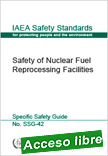 |
Safety of Nuclear Fuel Reprocessing Facilities Specific Safety Guide
IAEA Safety Standards Series, 2017, 119 p.
This publication provides guidance on meeting the requirements of IAEA Safety Standards Series No. NS-R-5 (Rev.1) relating to nuclear fuel reprocessing facilities. It covers the lifetime of these facilities, from site selection through to decommissioning, concentrating on the design and operational phases. |
It applies to facilities that reprocess spent fuel and other material from nuclear power plants that use metallic and oxide fuels, including materials from mixed oxide fuel (MOX) and breeder reactors. It covers the safety issues relating to: the handling of spent fuel; mechanical treatment and the dissolution of spent fuel in acid; the separation of uranium and plutonium from fission products using solvents; the separation and purification of plutonium and uranium; and the production and storage of solutions and oxides to be used as feed material to form fresh uranium or mixed (UO2/PuO2) oxide fuel.
Extraído de: http://www-pub.iaea.org/books/IAEABooks/10994/Safety-of-Nuclear-Fuel-Reprocessing-Facilities
|
 |
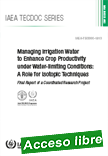 |
Managing Irrigation Water to Enhance Crop Productivity under Water-limiting Conditions: A Role for Isotopic Techniques - Final Report of a Coordinated Research Project
IAEA TECDOC, 2017, 180 p.
This Coordinated Research Project (CRP) on ‘Managing Irrigation Water to Enhance
Crop Productivity under Water-Limiting Conditions: A Role for Isotopic Techniques’ established and supported a research network and teams of scientists in eleven Member States consisted of Australia, Austria, China, Malawi, Morocco, Pakistan, Spain, Turkey, United States, Viet Nam and Zambia. |
The main objective of the CRP was to improve crop wáter productivity (production per unit of water input) under water-limiting conditions. The specific objectives of the CRP were to: (i) Quantify, and develop means to manage soil evaporative losses to maximise the beneficial use of water – the transpirational component of evapotranspiration, (ii) Quantify, and develop means to improve the amount of biomass produced per unit of transpiration, and (iii) Devise irrigation and related management techniques to enhance the yield component of biomass production (Harvest Index).
The CRP aimed to improve crop water productivity under water-limiting conditions
using isotopic and related techniques, by supporting Member States in their efforts to optimize water use efficiency and its sustainability as well as increasing crop yield. The proportion of water lost as soil evaporation (E) versus plant transpiration (T) relative to the total evapotranspiration (ET) can affect crop productivity at various spatial and temporal scales. The ability to accurately quantify water loss from the plant rooting zone and partitions total ET as E and T will help to evaluate the effectiveness of land and water management practices that influence E and T components. Stable isotopes of water (18O and 2H) and soil moisture neutron probe (SMNP) and conventional approaches such as the eddy covariance,
mini-lysimetry and canopy cover determination were used to quantify components of soil evaporation and crop transpiration under different irrigation management practices, crop species and growth stages. The FAO’s AquaCrop model was used to compare the experimental and simulated results to improve crop water productivity.
Extraído de: http://www-pub.iaea.org/MTCD/Publications/PDF/TE-1813_web.pdf
|
 |
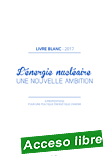 |
L’Énergie Nucléaire - Une Nouvelle Ambition
Société Française d’Energie Nucléaire (SFEN), Février 2017, 36 p.
La SFEN publie pour la première fois, un livre blanc de propositions destiné aux candidats à l’élection présidentielle. Ce travail, fruit des réflexions de ses membres, professionnels et spécialistes de l’énergie nucléaire, révèle la nécessité de donner une nouvelle ambition à la filière nucléaire française.
|
Extraído de: http://www.sfen.org/fr/rgn/une-nouvelle-ambition-pour-lenergie-nucleaire
|
 |
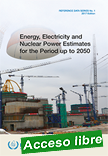 |
Reference Data Series No. 1 (RDS-1) is an anual publication — currently in its thirty-seventh edition — containing estimates of energy, electricity and nuclear power trends up to the year 2050.
RDS-1 starts with a summary of the status of nuclear power in IAEA Member States as of the end of 2016 based on statistical data collected by the IAEA’s Power Reactor Information System (PRIS).
|
It then presents estimates of energy and electricity up to 2050 derived from various international studies, including the International Energy Agency’s World Energy Outlook 2016 and the United States Energy Information Administration’s International Energy Outlook 2016. The energy and electricity data for 2016 are estimated, as the latest information available from the United Nations Department of Economic and Social Affairs is for 2014. Population data originate from World Population Prospects (2015 revision), published by the Population Division of the United Nations Department of Economic and Social Affairs. The 2016 values again are estimates.
As in previous editions of RDS-1, projections of nuclear power are presented as low and high estimates encompassing the uncertainties inherent in projecting trends. The projections are based on a critical review of (i) the global and regional energy, electricity and nuclear power projections made by other international organizations, (ii) national projections supplied by individual countries for a recent OECD Nuclear Energy Agency study and (iii) the estimates of the expert group participating in the IAEA’s yearly consultancy on nuclear capacity projections.
Extraído de: http://www-pub.iaea.org/books/IAEABooks/12266/Energy-Electricity-and-Nuclear-Power-Estimates-for-the-Period-up-to-2050
|
 |
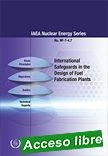 |
International Safeguards in the Design of Fuel Fabrication Plants
IAEA Nuclear Energy Series, 2017, 52 p.
This publication is the third in a series from the IAEA that provides guidance on the early consideration of safeguards requirements in the design and construction of nuclear facilities. It is principally intended for designers and operators of nuclear fuel fabrication facilities; however, vendors, state authorities and investors may also benefit from the information provided. |
This guidance is introductory rather than comprehensive; more detailed information on IAEA safeguards implementation can be found in the Guidance for States Implementing Comprehensive Safeguards Agreements and Additional Protocols (IAEA Services Series No. 21, May 2016) and other publications in that series. This publication expands upon the general considerations addressed in International Safeguards in Nuclear Facility Design and Construction (IAEA Nuclear Energy Series No. NP-T-2.8, April 2013).
Extraído de: http://www-pub.iaea.org/books/IAEABooks/10746/International-Safeguards-in-the-Design-of-Fuel-Fabrication-Plants
|
 |

|
World Nuclear Industry Status Report 2017
Mycle Schneider Consultant, September 2017, 267 p.
The World Nuclear Industry Status Report 2017 (WNISR2017) provides a comprehensive overview of nuclear power plant data, including information on operation, production and construction. The WNISR assesses the status of new-build programs in current nuclear countries as well as in potential newcomer countries. |
The WNISR2017 edition includes a new assessment from an equity analyst view of the financial crisis of the nuclear sector and some of its biggest industrial players. The Fukushima Status Report provides not only an update on onsite and offsite issues six years after the beginning of the catastrophe, but also the latest official and new independent cost evaluations of the disaster. Focus chapters provide in-depth analysis of France, Japan, South Korea, the United Kingdom and the United States. The Nuclear Power vs Renewable Energy chapter provides global comparative data on investment, capacity, and generation from nuclear, wind and solar energy. Finally, Annex 1 presents a country-by-country overview of all other countries operating nuclear power plants
Extraído de: https://www.worldnuclearreport.org/
|
 |
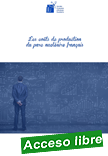 |
Les Coûts de Production du Parc Nucléaire Français
Société Française d’Energie Nucléaire (SFEN), Septembre 2017, 34 p.
Le ministère de la Transition Ecologique et Solidaire a engagé des travaux concernant les scénarios qui sous-tendront la révision de la Stratégie Nationale Bas Carbone (SNBC) et de la Programmation Pluriannuelle de l’Energie (PPE), à l’horizon fin 2018. La Société Française d’Energie Nucléaire (SFEN) souhaite participer et contribuer aux réflexions de ces groupes de travail, en apportant l’expertise de ses sections techniques.
|
D’une manière générale, elle : Rappelle que l’enjeu prioritaire de la PPE est la réduction de la consommation d’énergies fossiles, importées et émettrices de gaz à effet de serre; Comprend le souci pragmatique de certains Français de diversifier le mix électrique et de ne pas « mettre tous les oeufs dans le même panier »; Estime que la diversification du mix électrique devra se faire en temps et en heure, à mesure de l’amélioration des performances économiques et techniques des énergies renouvelables.
Extraído de: http://www.sfen.org/sites/default/files/public/atoms/files/note_-_les_couts_de_production_du_parc_nucleaire_francais_-_ppe_-_sfen.pdf
|
 |
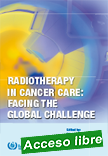 |
Radiotherapy in Cancer Care: Facing the Global Challenge
IAEA Non-serial Publications, 2017, 544 p..
Cancer treatment is complex and calls for a diverse set of services. Radiotherapy is recognized as an essential tool in the cure and palliation of cancer. Currently, access to radiation treatment is limited in many countries and non-existent in some. This lack of radiotherapy resources exacerbates the burden of disease and underscores the continuing health care disparity among States. |
Closing this gap represents an essential measure in addressing this global health equity problem. This publication presents a comprehensive overview of the major topics and issues to be taken into consideration when planning a strategy to address this problem, in particular in low and middle income countries. With contributions from leaders in the field, it provides an introduction to the achievements and issues of radiation therapy as a cancer treatment modality around the world. Dedicated chapters focus on proton therapy, carbon ion radiotherapy, intraoperative radiotherapy, radiotherapy for children, HIV/AIDS related malignancies, and costing and quality management issues.
Extraído de: http://www-pub.iaea.org/books/IAEABooks/10627/Radiotherapy-in-Cancer-Care-Facing-the-Global-Challenge
|
 |
|
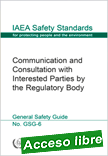
|
Communication and Consultation with Interested Parties by the Regulatory Body - General Safety Guide
IAEA Safety Standards Series, 2017, 45 p.
This Safety Guide provides recommendations on meeting the safety requirements concerning communication and consultation with the public and other interested parties by the regulatory body about the possible radiation risks associated with facilities and activities, and about processes and decisions of the regulatory body. The Safety Guide can be used by authorized parties in circumstances where there are regulatory requirements placed on them for communication and consultation.
|
It may also be used by other organizations or individuals considering their responsibilities for communication and consultation with interested parties.
Extraído de: http://www-pub.iaea.org/books/IAEABooks/11029/Communication-and-Consultation-with-Interested-Parties-by-the-Regulatory-Body
|
 |
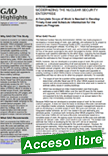 |
Modernizing the Nuclear Security Enterprise: A Complete Scope of Work Is Needed to Develop Timely Cost and Schedule Information for the Uranium Program
Government Accountability Office (GAO - US), September 8, 2017, 48 p.
Uranium is crucial to our nation’s ability to maintain its nuclear weapons stockpile. NNSA processes uranium to meet this need. In 2004, NNSA began plans to build a new UPF that would consolidate capabilities currently housed in deteriorating buildings; by 2012, the project had a preliminary cost of $4.2 billion to $6.5 billion.
|
To control rising costs, NNSA changed its approach in 2014 to reduce the scope of the new UPF and move uranium processing capabilities once intended for the UPF into existing buildings. The broader uranium program also includes the needed repairs and upgrades to these existing buildings.
The National Defense Authorization Act for Fiscal Year 2013 as amended includes a provision for GAO to periodically assess the UPF. This is the fifth report and (1) describes the status of NNSA’s efforts to develop a revised scope of work, cost estimate, and schedule for the UPF project, and (2) examines the extent to which NNSA has developed a complete scope of work, life-cycle cost estimate, and integrated master schedule for the overall uranium program. GAO reviewed program documents on planning, strategy, cost, and implementation and interviewed program officials to examine the program’s scope, cost and schedule.
Extraído de: http://www.gao.gov/assets/690/687026.pdf
Highlights: http://www.gao.gov/assets/690/687026.pdf
Report: http://www.gao.gov/products/GAO-17-577
|
 |
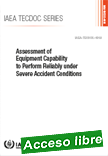 |
Assessment of Equipment Capability to Perform Reliably under Severe Accident Conditions
IAEA TECDOC, 2017, 124 p
The experience from the last 40 years has shown that severe accidents can subject electrical and instrumentation and control (I&C) equipment to environmental conditions exceeding the equipment’s original design basis assumptions. Severe accident conditions can then cause rapid degradation or damage to various degrees up to complete failure of such equipment.
|
|
|
|
| |
|
|
| |
| |
|
|
| |
| |
|
|
| |
| |
|
|
|
